As noted in my last article, electrification has helped make it much easier to ride cargo bikes, so they become car replacement vehicles for ordinary people who don’t have the leg power to push a heavy bike. However, just as important as adding an electric motor has been the advent of long-tailed cargo bikes, which have longer racks in the back for carrying kids, groceries, work tools, etc. The long-tail helped popularize cargo bikes and make them accessible to the general public.
The Long John or bakfeits style bike with a flat rack or box in the front of the rider is arguably the best type of cargo bike for carrying heavy weight, but those types of bikes are very expensive and they don’t have the maneuverability and balance of a normal bike, plus they are much longer than a normal bike. For people who want a cargo bike that handles like a normal bike and they don’t want to pay too much for the ability to carry around extra weight, the long-tail cargo bike is the best option.
The cheapest long-tail cargo e-bikes used to cost over $4000, but Rad Power Bikes made them far more accessible to the general public when it introduced the RadWagon in 2015 for $1599. At that price, many cyclists started buying long-tail bikes and the market exploded, which caused many new bike manufacturers to start making models to compete with the RadWagon. However, the price that Rad Power charged for its cargo bike rose to $1999, when it introduced the RadWagon 4 in 2020. The new model had custom 22 x 3″ wheels, which proved to be a public-relations nightmare for the Seattle-based company. The rims in the custom wheels had a tendency to misalign and cause tire punctures. Rad Power had to recall 29,300 RadWagon 4’s, which harmed the company’s reputation as the best budget e-bike manufacturer.
The quality of budget long-tail cargo e-bikes got significantly better when Aventon introduced the Abound for $1799 in February 2023. Aventon designed the bike to look and ride like Riese & Müller’s Multitinker, but it costs a fourth of the price. Not only is Aventon’s cargo e-bike $200 cheaper than Rad Power’s, but it features a front suspension fork, a torque sensor, a battery incorporated into the frame’s down tube, hydraulic disk brakes, turn signals and an in-frame bag, which are all features that the RadWagon 4 lacks.
Lectric further eroded Rad Power’s market position, when it introduced the Xpedition for $1399 in the same month, with a more powerful 750W motor that could go up to 28 mph with pedal assistance (class 3) and a rear rack incorporated into the frame that was capable of hauling up to 300 lbs. Even more impressive, Lectric offered a two battery model of the Xpedition for $1699, which extended the range of the bike to 150 miles at pedal assist level 1.
Aside from a few short-term sales on the RadWagon 4 ($1499 for 8 days in Feb. 2023 and $1799 for a day in June 2023), Rad Power failed to respond to its competitors’ offerings until it announced its upcoming RadWagon 5 on March 5, 2024 with better specs, but a $200 price hike to $2199. Rad Bikes appears to have decided with its 2024 models that it can’t compete at the low end of the market, so it is best to position itself as mid-range brand that offers better products at a higher price point than the budget brands.
The question for the Seattle-based company is whether its brand reputation is good enough to allow it to move upstream. Aside from the special heat absorbing resin in its new Safe Shield batteries that is designed to decrease the risk of thermal runaway (i.e., fires), the RadWagon 5 doesn’t appear to be a better bike than its competition. In fact, it is arguable a worse bike, considering that it is heavier than the other cargo bikes, but its frame is weaker and its back rack holds less weight.
In trying to decide which budget long-tail cargo bike would be best to buy, I created the following table to compare their specs:
| Comparing long-tail cargo e-bikes, available in the U.S. | |||||
| Model | AiPAS A6 | Lectric Xpedition | Aventon Abound | HOVSCO HovCart | Velotric Packer 1 |
| Price USD (dual battery) | 1399 (1599) | 1475 (1699) | 1799 | 1899 | 1999 |
| Warranty | 1 yr | 1 yr | 2 yr | 1 yr (2 yr frame, 0.5 yr components) | 2 yr |
| Tires | CST 20×3″ | 20×3″, puncture resist slime | 20×2.4” | 20×4″ | 26×2.4″ (F), 20×3″ (B), puncture resist |
| Battery (dual battery) | LG 48V, 14.4 (28.4) Ah** | 48V, 14 (28) Ah | 48V, 15 (30*) Ah | Samsung/LG 48V, 15Ah | LG 48V, 14.4 Ah |
| Miles range (dual battery) | 70 (155) | 75 (150) | 50 (100*) | 60 (PAS), 40 (throttle) | 52 |
| Charger | 54.6V, 2A | 54.6V, 2A | 48V, 3A | 48V, 3A | |
| Certifications | UL2849 | UL2849, UL2271, DIN 79010:2020-02.5.9.5.2 | UL2849 | IPX5 | UL2271, UL2849 |
| Motor | 750W (1300W peak)†, 85 Nm hub | 750W (1310W peak), 85 Nm hub | 750W (1130W peak) hub | SUTTO 750W (1032W peak), 85 Nm hub | 750W (1200W peak), 75 Nm, hub |
| Cassette | 7-speed | 7-speed, 11-28T | 7-speed, 14-28T | 7-speed, 14-28T | 8-speed, 13-34T |
| Crank set | 52T, 170mm arms | 48T, 170mm arms | 170mm arms | ||
| Rear derailleur | Shimano Tourney | Shimano Tourney | Shimano Tourney | Shimano | Shimano Altus |
| Sensor | cadence | cadence (PWR) | torque | torque | cadence |
| Top speed (mph) | 28 (20 default) | 28 (20 default) | 20 | 28 (20 default) | 25 (20 default) |
| Max payload (lbs) | 480 | 450 | 440 | 450 | 440 |
| Rear rack (max weight) | 21×6.75” (300 lb) | 31×6.8” (300 lb) | 674–151mm (143 lb) | 176 lb | |
| Suspension | 100mm front suspension | None | Suntour 50mm front fork | 80mm front fork | 80mm hydr. front fork |
| Brakes | Tektro hydr. 180mm | hydr. 180mm | Tektro hydr. 180mm | Tektro hydr. 180mm | 4-piston hydr. 180mm |
| Bike weight in lbs (dual battery) | 71 | 68 (75) | 81 | 66.4 | 75 |
| Color options | white, gray | fog grey | sage (light gray) | orange, gray | indigo gray, sky blue |
| Seat height (in) | 28 – 37 | 32 – 49 | 30.3 – 38.2 | 31;49 – 39.37 | |
| Handlebar height (in) | 41 – 44 | 40 – 45 | 46.26 | ||
| Standover height (in) | 22 | 18.75 | 18.6 | ||
| Rider height | 4’11” – 6’2″ | 4’11” – 6’5” | 4’11” – 6’3″ | 4’11” – 6’3″ | 5’3” – 6’6” |
| Dimensions (in) (folded) | 69 x 44 x 26 (69 x 28 x ?) | 72 x 46 x 25 (72 x 32 x 12) | 73.62 x 46.26 x 27.67 | 82 x ? x 26.8 | |
| Features / advantages | cruise control, walk mode, sport mode, turn signals, bell; quick adjustable handlebars, foldable stem & pedals; strong frame; quiet motor | cruise control, walk mode, sport mode, quick adjustable handlebars, foldable stem & pedals; strong frame | iOS/Android phone app, dropper seatpost, turn signals, in-frame bag, chain cover, foldable stem & pedals, nicer ride with torque sensor | iOS/Android app; emergency LED light in battery; lighter bike weight | Apple Find My, in-frame storage bag w/ TSA lock, rear mesh wheel guards, chain cover; USB charge port, IPX6 rated, 2.9 mph walk mode, 130 lux headlight |
| Included free accessories | 2 seat cushions, foot running boards, Orbitor cage, Orbitor bag, frame bag | extra 15Ah battery, foot running boards, rear seat cushion, back panniers, rear rack basket, rear rack board, cargo net | |||
| Observations | No accessories offered; can use Xpedition accessories, but costs more than the Xpedition after buying them from Lectric; only stores selling in Los Angeles area, central Florida and Detroit, so hard to get support and unclear if can get replacement parts in future | Noisy motor; no brake light; rough ride with no front suspension, so may need to buy a suspension seat; weak headlight; frame bag raises stepover height, unlike bags in the Abound and Packer 1; no chain cover; key must be inserted to use bike. | Only 4 levels of PAS; can’t go higher than 20 mph; weak rear rack for carrying cargo; offers free extra battery to compete with Xpedition, but no place to carry it on frame; riders with larger feet may scrape their heels on footboards | Only 5 accessories available; ghost pedaling over 24 mph; no UL certifications; | No second battery option so not good if needing long range; few accessories offered |
| * Aventon currently offers a free extra 15Ah battery with the Abound, but no place to carry it on the frame. ** AiPAS advertises a 15Ah single battery and 29Ah double battery, but other places say it is 14.4 and 28.4 Ah. † AiPAS advertises a 1500 watt motor, but reviewers say it is 750W (1300W peak). | |||||
| Model | Flyer L885 | Rad Power RadWagon 5 | Flyer Via (L886) | Flyer Via Pro | Specialized Globe Haul LT |
| Price USD (dual battery) | 1999 (2498) | 2199 | 2199 | 2499 | 3500 |
| Warranty | 1 yr (5 yr frame & fork) | 2 yr | 1 yr (5 yr frame & fork) | 1 yr (5 yr frame & fork) | 2 yr (lifetime frame) |
| Tires | CST 26×3” (F), 20×3” (B), puncture-resist liners | Kenda 20×3.3″ | Kenda 24×2.4″ (F), 20×2.4” (B), puncture resist | Kenda 24×2.4″ (F), 20×2.4” (B), puncture resist | 20×3.5” |
| Battery (dual battery) | 48V, 15 (30) Ah | LG/Samsung 48V, 15Ah, Safe Shield | Samsung 50E 48V, 15Ah | Samsung 50E 48V, 15Ah | 48V, 16Ah, IPX7 |
| Miles range (dual battery) | 50+ (100+) | 60 | 30 – 50+ | 30 – 50+ | 60 |
| Charger | 54.6V, 2A | 48V, 2A | 54.6V, 2.5A | ||
| Certifications | UL2271 | UL2271, UL2849 | UL2849, UL2271, UL1310, DIN 79010 (frame) | UL2849, UL2271, UL1310, DIN 79010 (frame) | UL 2271, IPX7 (battery), IP65 (wiring) |
| Motor | 500W hub | 750W, 90 Nm, hub | 500W hub | 750W hub | 700W hub |
| Cassette | 7-speed, 14-28T | 7-speed, 11-34T | 7-speed, 12-28T | 8-speed | SunRace 9-Speed, 11-36T |
| Crank set | 44T, 170mm | 50T, 170mm arms | 56T, 165 mm arms | 56T, 165 mm arms | 50T, 160 mm arms |
| Rear derailleur | Shimano Tourney | Shimano | Shimano Tourney TY300 | Shimano Altus | microSHIFT |
| Sensor | cadence | torque | torque | torque | torque |
| Top speed (mph) | 20 | 28 (20 default) | 20 | 20 | 28 |
| Max payload (lbs) | 400 | 375 | 400 | 400 | 441 |
| Rear rack (max weight) | 150 lb | 120 lb | 150 lb | 150 lb | |
| Suspension | None | RST Guide 45mm front fork | None | front suspension fork | None |
| Brakes | Tektro cable 180mm | Tektro hydr. 180mm | Tektro hydr. 180mm | Tektro hydr. 180mm | Tektro HD-T535 4-piston hydr. 203mm |
| Bike weight in lbs (dual battery) | 73 | 86 | 68 (S) / 68.5 (M) / 69 (L) | 68 (S) / 68.5 (M) / 69 (L) | 88 |
| Color options | black, red, white, blue | metallic blue, black | black, sage green, yellow | black, forest green, grey blue | gloss white |
| Seat height (in) | 27.0 – 35.5 | 30.5 – 41.8 | 28.5-37 / 32-40.5 / 34.5-43 | 28.5-37 / 32-40.5 / 34.5-43 | 20.4 – 33.5 |
| Handlebar height (in) | 41.0 – 43.75 | 44″ | 40.5-41.5 / 42-43 / 44-45 | 40.5-41.5 / 42-43 / 44-45 | 41.4 – 46.9 |
| Standover height (in) | 19 | 21 | 18 / 18.5 / 19 | 18 / 18.5 / 19 | 20.1 |
| Rider height | 4’10” – 6’6” | 4’11”-6’3″ | 4’10” – 6’10” | 4’10” – 6’10” | 4’5” – 6.4” |
| Dimensions (in) (folded) | 83.8 x 44 x ? | 76 x 44 x 26.8 | 75×41 (S) / 75×42 (M) / 77×44 (L) | 75×41 (S) / 75×42 (M) / 77×44 (L) | ~76 x 41.4 x 27.6 |
| Features / advantages | bell; deflopilator spring on front wheel, 3 frame sizes | USB-C charger port, turn signals, bell, 200 lumen headlight | turn signals, brake light and motor cutoff, deflopilator spring on front wheel, chain cover, 3 frame sizes | turn signals, brake light and motor cutoff, deflopilator spring on front wheel, chain cover, 3 frame sizes | 1500 lumen headlight, 50 lumen taillight, brass bell, fits the shortest riders (>=4’5”) |
| Included free accessories | foot running boards, rear seat cushion with back rest, handrail cage | foot running boards, rear seat cushion with back rest, handrail cage | |||
| Observations | No hydraulic breaks; no chain cover. | Frame is weak and rear rack can’t carry much cargo, but it’s the heaviest bike; higher priced than competitors; no chain tensioner; no chain cover; no second battery option for longer range. | No reflector strips on tires; no second battery option; single-sided chainguard | No reflector strips on tires; no second battery option; single-sided chainguard | installing foot running boards requires taking off back wheel; no second battery option; no chain cover; heavy bike and doesn’t list max rack weight. |
See the spreadsheet with more models:
Looking at the specs of the budget long-tail cargo bikes, the AiPAS A6 stands out as offering the best value for the price. The A6 has the lowest price of all the models, but many of the needed accessories come included for free with the Lectric Xpedition and Aventon Abound. AiPAS offers very few accessories, but the accessories for the Lectric Xpedition are compatible with the A6. After buying those accessories from Lectric, the A6 will end up costing more than the Xpedition for most people. However, the A6 fixes many of the shortcomings in the Xpedition, offering a front suspension fork, brake light, turn signals, a stronger headlight, bell, a little deeper tread on the tires, a quieter motor, and better balance in the front by moving one of the batteries to the down tube. Its front suspension fork has the most travel of all the long-tail cargo bikes on the market. Like the Xpedition, the A6 has a quick release to adjust the handlebars. On the other hand, the A6 lacks a chain cover to protect the pants of the rider and several of the reviewers commented that its seat is hard.

Although AiPAS is an unknown brand, it is owned by Galaxy Bicycle in China, which is rumored in YouTube comments to be the original design manufacturer (ODM) for Lectric’s bikes. Looking at the Xpedition and A6, it is not hard to see similar design cues in the two bikes, so they probably were designed by the same company. AiPAS A6’s Amazon listing says: “In 2019 we established a close partnership with renowned US ebikes, providing them with robust production and manufacturing process. Our collaboration helped this brand establish a comprehensive image as an electric bicycle travel brand, providing superior travel services to a wide range of consumers.”
The one thing that gives me pause about buying the bike is the fact that the only bricks-and-mortar stores selling AiPAS bikes are located in the Los Angeles area, Detroit and central Florida, so it will be hard to get support for the bike after its warranty expires in one year. In contrast, bike stores can be found all over the US for Lectric, Rad Power and Aventon, which offer support for their bikes, and Rad Power, Aventon and Velotric offer 2 year warranties for their bikes. I prefer to work on my own bikes if something breaks, but the AiPAS web store only sells a few replacement parts, so it may not be possible to get replacement parts.
Worried about the lack of long-term support, I asked on Reddit’s r/ebikes channel whether anyone had experience with AiPAS and their thoughts about the Xpedition vs the A6. One person responded, saying:
I have both bikes I'll keep it short I use the A6 and the XPedition collects dust, the A6 is better all around.
Also in regard to parts, Aipas basically cloned the Xpedition then added additional features that make it better, that being said all the parts for the XPedition work on the Aipas like the batteries, accessories, brakes, rotors....so parts are not a problem.
The few reviews that I can find of AiPAS’s bikes seem to indicate that they are good, but almost all of them are reviewers who get a kickback from the company when anyone orders the bike with their discount code, so they have a financial incentive to not be very forthright if the bike is bad. At any rate, almost no bike reviewers focus on the long-term durability and fixability of a bike, since most of them publish their opinions after a few test rides.
The other thing that gives me pause is the fact that the AiPAS web site claims that the A6 has a 1500 watt motor, when the reviews say its motor is nominally 750W (meaning it can run continuously at that level of power) with a 1300W peak. The web site also claims that the A6’s dual battery holds 29 Ah, when the reviews say it is 28.4 Ah, and it lists the range at 155 miles, when the Xpedition with a similar motor and the same sized battery says 150 miles. I doubt that anyone will get much over 120 miles with a 28.4 Ah battery in real world riding, even at pedal assist level 1. These kinds of exaggerations make me inclined to distrust the company, but it is such a good deal, that I probably would buy the bike if I had the money.
However, for people who don’t want to take a risk with a Chinese brand like AiPAS, there doesn’t appear to me to be a clear winner among the rest of the budget models. All the available budget models have tradeoffs, so the question is what features are most important to you, such as longer range, higher speeds, a stronger rack for carrying cargo, better suspension for rough roads, larger pannier bags, weather protection for the kids, rear rack seats for adults, a torque sensor, smoother shifting, better braking, local maintenance support, long-term access to parts, etc.
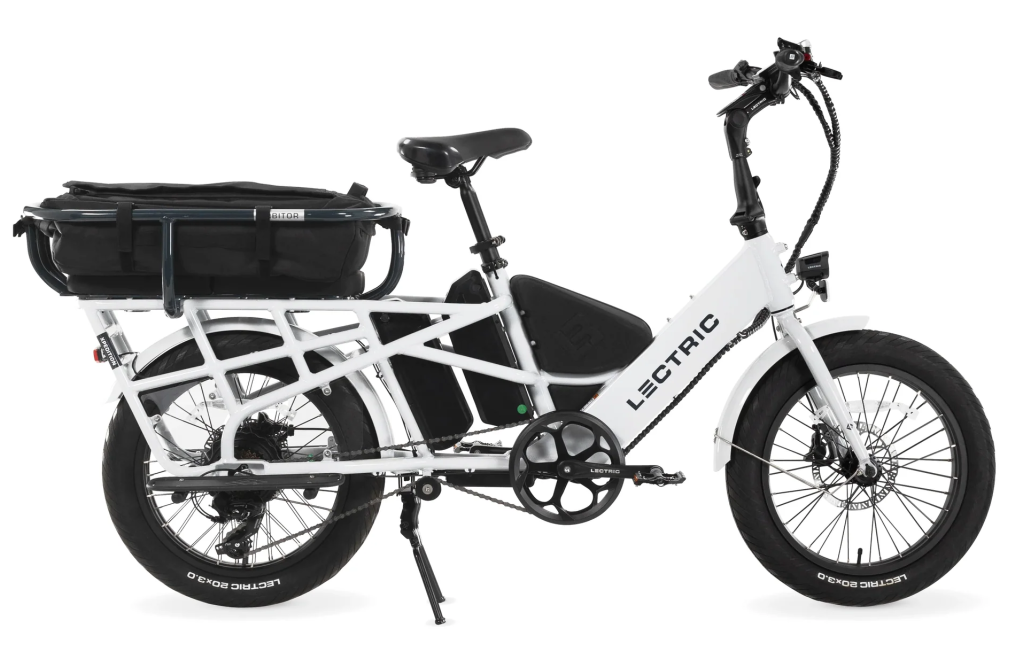
For people who need to carry heavy loads, go long distances or need a powerful motor to get up hills and go faster than 20 mph, the Lectric Xpedition is a good option, but the motor will be noisy, the ride will be bumpy with no suspension and the bikes doesn’t offer brake lights, turn signals or a bell/horn, so third party accessories have to be installed to get those features. Lectric’s current sale which includes 2 cushions for the back rack, foot running boards, an Orbitor cage, an Orbitor bag and a frame bag for free with the bike is an incredible deal for people who want those accessories. For people carrying kids on the back, the Xpedition is the most affordable option.
Like the AiPAS A6, the Xpedition supports up to 300 lbs of weight on the back rack, which makes those two bikes the best options for carrying heavy loads. Although anyone who intends to transport that much weight on a regular basis should probably consider getting a Long John-style bike or a cargo trike, because all that weight is going to unbalance any long-tail bike and make it difficult to handle. Maybe heavier riders will have the heft to counterbalance heavy loads on the back, but it is safer to carry heavy weights in the middle of a Long John or between two wheels on a cargo trike. However, the AiPAS A6 and Xpedition should be good bikes for carrying a second adult passenger on the back (see the Accessories section below), whereas the other budget cargo bikes are only designed to support kids on the back.
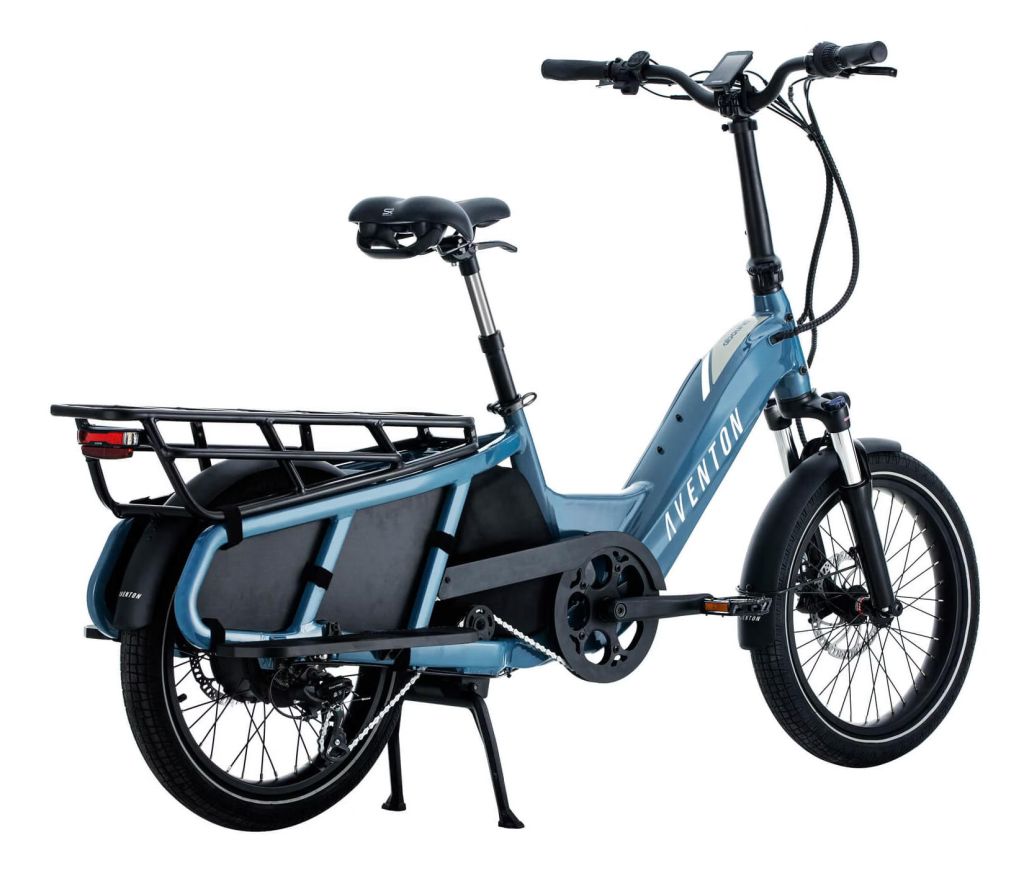
For people who want a torque sensor, and a better riding bike in general, but don’t mind the 20 mph speed limit and the bike’s limited cargo capacity, the Aventon Abound is the best choice. The Abound’s dropper seat is very useful when wanting to put both feet on the ground to steady a heavy load at stop lights, and the in-frame bag is a handy place to store stuff when riding. In my opinion, the Abound is the best-looking of the long-tail cargo bike models with the battery incorporated into the down tube and smoothed-out weld joins in the frame. The clean lines in the back section of the frame and black bolt-on rack are aesthetically pleasing to the eye, but the rear rack only supports a maximum of 143 lbs, which is a major drawback of the bike.
Aventon’s current sale offers nearly every useful accessory for free, including an extra 15Ah battery, foot running boards, rear pannier bags, rear rack basket, rear rack bamboo board, seat pad, handrail cage and cargo net, which makes the Abound at $1799 a stellar deal. However, remember that the second battery included in the current sale will need to be tied down on the back rack or carried in a backpack, since there is nowhere to carry it on the frame. Lectric and Aventon are engaged in a running battle to see which company can offer the most accessories for free to attract customers, which has to harm their profits, since selling accessories is where bike sellers usually have their highest margins. Aventon recently started including the rear rack basket for free, which makes it very attractive for people who need to haul large objects. In my opinion, Abound’s handrail cage is more useful than the Orbitor cage that comes with the Xpedition, because it looks to be compatible with the handrails used by other bike manufacturers, so the Abound in theory should be able to accept accessories designed for those handrails, but that needs to be verified by trying out accessories from other manufacturers to see if they work on the Abound.
For people who have limited storage space, the AiPAS A6, Lectric Xpedition and Aventon Abound all feature smaller 20″ wheels, fold down handlebars, quick release seats posts and folding pedals, which allows them to be stored in spaces with less height and width. However, their frames make them longer than a normal bike. People who need a cargo bike that can be stored in smaller spaces, should consider the Flyer Folding Cargo (M860) with a mid-tail which has less rack space than a long tail, but is still designed to carry loads. However, it has a weak 350W motor, a 300 lb max weight capacity and a rear rack that can only carry a maximum of 80lbs, so it might be better to consider the Lectric XP 3.0, which can carry up to 150 lbs on its rear rack and has a second passenger option.

Another new cargo bike that was released in mid-2023 is the HOVSCO HovCart, which currently costs $1899. HOVSCO only offers 5 accessories for the bike (front basket, rear basket, handrail cage, foot running boards and rear rack seat cushion) and there is no second battery option, so the bike has limited expandability. None of the accessories are included for free, but HOVSCO does offer the bike with the child carrying accessories for $2076. The bike’s unique feature is a long LED light bar in the battery that can be used as a flashlight or an emergency light.
HOVSCO doesn’t list the max weight capacity for the back rack, but the company’s web site shows a picture of a second adult riding on the back, and one review says its rear rack can hold “about 250 lbs”, which makes it one of the stronger bikes for hauling cargo. The HovCart has a torque sensor and powerful 750W, 85 nm motor, so it is good for riding up to 28 mph, but reviews say that it has ghost pedaling above 24 or 25 mph, so pedaling won’t help it go faster at higher speeds. However, it isn’t hard to install a larger front chain ring with more teeth.
The HovCart is a good option for someone that wants wider 4″ tires and knobby tread for riding off-road. The bike’s web page contradicts itself, saying in the “Specs” section that the front suspension fork has 45 mm of travel, but below it says that it has 80 mm of travel, so HOVSCO may have changed its fork. As one reviewer commented, “Unfortunately, it only has 45-milimeters of travel which is just enough to make riding over pavement comfortable – but not much else. I took this bike to my local dirt trail, and my back and buttcheeks were sore for the whole day.”

The Velotric Packer 1 has a front suspension fork and a 26 inch front wheel, so it rides more like a normal bike. It has an adjustable stem for some reach adjustment, but the handlebar height can’t be raised like on the Xpedition, A6 and Abound. The Packer 1’s smaller 20 inch back wheel keeps the weight on the back rack lower to the ground. Its major limitation is the fact that it doesn’t offer a second battery option, so it will be a poor choice for long distance riding. It also isn’t a good option for people who have limited storage space, since it is a longer bike and doesn’t fold. The fact that it costs $1999 and doesn’t include any of its accessories for free is going to make it significantly more expensive than the Xpedition and Abound once it is outfitted. Velotric offers fewer accessories (foot running boards, rack seat pads, medium rear basket, large rear basket, front basket, handrail cage and rear passenger handlebars) than other cargo bike sellers, so accessories like pannier bags, rear seats with back support and rear canopies have to be jerry-rigged from other manufacturers.
On the other hand, the Packer 1 has 8 gears, a Shimano Altus M310-8 rear derailleur, and 4 piston hydraulic brakes, which is a little better quality than the 7 gears, Shimano Tourney derailleurs and double piston hydraulic brakes found on the other budget cargo e-bikes. Of course, all the derailleurs used on budget cargo bikes will be noisier and less smooth when shifting compared to the higher-end bikes made by Specialized, Tern, Yuba, Xtracycle and Reise & Müller, but the Altus derailleur on the Packer 1 should be a bit more precise in shifting than a Tourney derailleur.
Like the Aventon Abound, the Packer 1 includes an in-frame bag behind the seat post instead of a double battery option, but the Packer 1’s bag has a handy TSA lock. I’d be leery of leaving anything valuable in that bag when parking the bike, since someone could still cut open the bag with a knife, but it still a useful feature to have the equivalent of a car’s glove compartment on your bike. Another extra security feature included in the Packer 1 is Apple’s Find My, which is useful if needing to track the bike and worried about theft. However, some police departments can’t be bothered to help people recover their stolen bikes, so it is worth looking on local bike forums to find out how the police treat bike theft in your area before buying if you plan to use that feature.
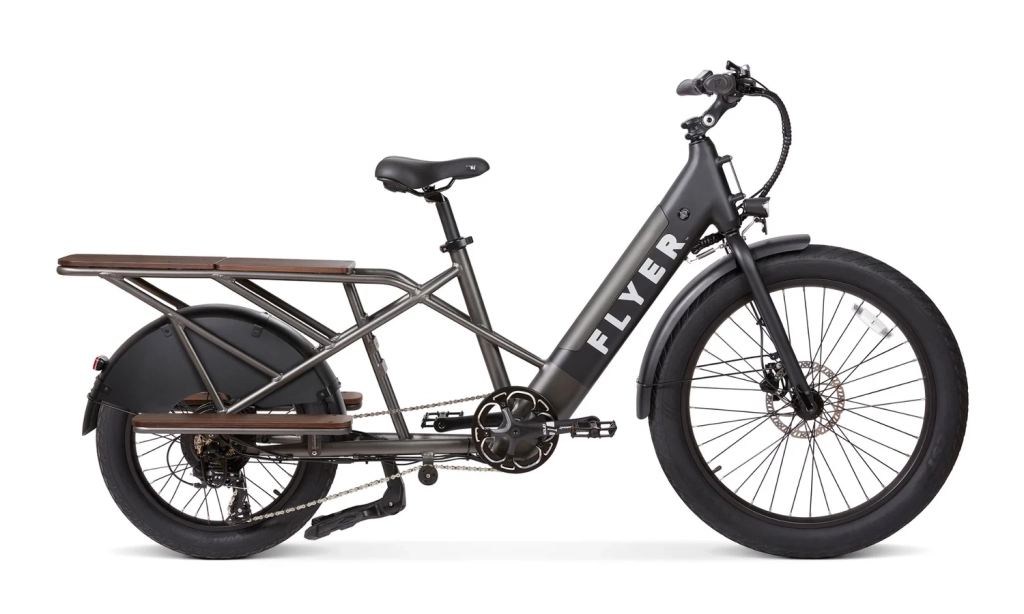
The Flyer L885 offers a similar ride to the Velotric Packer 1, with a larger 26″ wheel in the front and a 20″ wheel in the back, but it doesn’t have a front suspension fork and comes with a 20 mph speed limit (class 2). It has a less powerful 500W motor, so it probably isn’t the bike to buy if needing to climb steep grades. The second battery option on the L885 is nice, but pricey at $500 extra. Without a front suspension fork, the L885 will provide a bumpy ride, but the 3″ wide tires should provide some cushioning. Like the Xpedition, riders may want to buy an third-party suspension seat post to cushion the ride. The L885 also has a “deflopilator” spring on the front wheel which keeps it from flopping to the side when parked, which is handy when loading and unloading the bike. The L855 is marketed for families carrying kids, but it is hard to recommend the bike, given that the Xpedition and Abound are much cheaper, with free accessories for carrying kids. Most people who want the greater stability of a large front wheel will opt for the Velotric Packer 1, but the Flyer L885 makes sense for shorter riders, who can’t ride the larger Packer 1, and for people who need more range with L885’s double battery option.
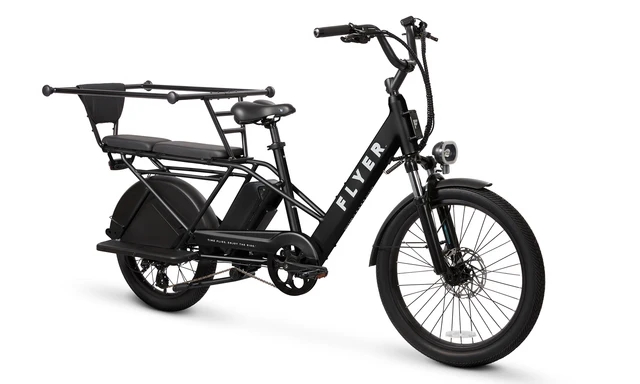
Flyer also offers the Via for $2199 with a 500W motor and the Via Pro for $2499 with a 750W motor and a better 8 gear cassette and derailleur, for people who are willing to pay a bit more. Both models are limited to a max of 20 mph. These models include a front suspension fork, a torque sensor, a better color display, a mobile phone app, deflopilator spring, foot running boards, a kid-carrier cage with hand rails and a rear rack seat cushion with back support. They offer three frames sizes, for different sized riders, and BMX-style handlebars, which allow for reach adjustment, but not height adjustment. However, there is no option for a second battery to augment the 15Ah battery.
Rad Power’s upcoming RadWagon 5 adds a bunch of new features to make its cargo bike more competitive, including a new front suspension fork with 45 mm of travel, turn signals and a USB-C charging port. Thankfully, the RadWagon 5 will use standard 20″ wheels, unlike the RadWagon 4, so it will be easier to find replacement third-party tires and rims for the bike. Its most important change is a new 750 watt, 90 nm motor with 50% more torque than the previous version, so the RadWagon 5 can now power up steep hills and increase its top pedal assist speed from 20 mph (class 2) to 28 mph (class 3). Rad Power has upgraded its entire line-up of bikes to use its new Safe Shield batteries, with a special resin that absorbs heat and prevents corrosion, which makes the batteries less likely to catch fire and degrade from exposure to humidity and heat. For shorter riders, the RadWagon 5 offers a lower step-over height and lower seat post height than the RadWagon 4, plus the option of a smaller frame size.
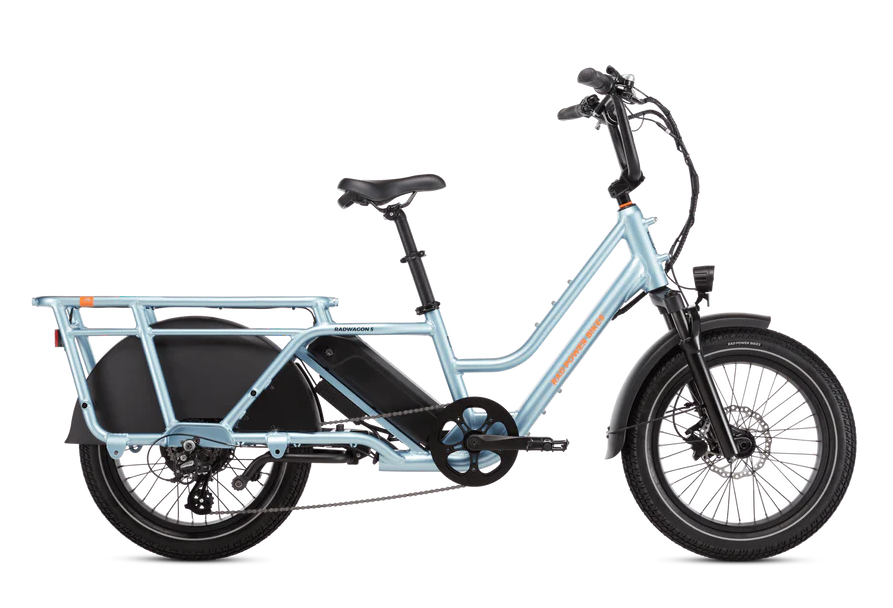
However, I question whether it is worth paying the higher price for the RadWagon 5. I have read a number of people complaining online about getting poor customer service from Rad Power Bikes. We will see if the new CEO can turn the company around, but it appears that Rad Power is gambling that its greater brand recognition will allow it to sell at higher prices than the competition. After seeing the 300 lb max weight limit on the back rack and dual battery option on the Xpedition, it is disheartening that Rad Power isn’t trying to compete with similar features. The RadWagon 5’s back rack supports a maximum of 120 lbs, which limits its usefulness as a cargo bike, yet the bike weighs more than its competitors. It lacks the option to add a second battery, and at $2199 with no free accessories included, it is pricey. However, it is a good option for people who want a safer battery or a faster class 3 cargo bike with a torque sensor.
Of course, there are more expensive long-tail cargo bikes on the market among the 35 models of long-tail cargo e-bikes currently available in the US market:
- Budget models:
- AiPAS A6 ($1399/$1599)
- Lectric Xpedition ($1475/$1699)
- Blix Packa Genie ($1499/$1699)
- Addmotor Garootan M-81 ($1599), GRAOOPRO ($1799/$2498)
- Eunorau MAX-CARGO ($1699 – $2598), G30-CARGO ($1899 – $2598)
- Aventon Abound ($1799)
- Rad Power RadWagon 4 ($1799), RadWagon 5 ($2199)
- HOVSCO HovCart ($1899)
- Velotric Packer 1 ($1999)
- Flyer L885 ($1999/$2498), Via (L886) ($2199), Via Pro ($2499)
- Mid-range models:
- Bike Friday Haul-a-Day Elite ($2684/$2850)
- Murf The Higgs Cargo ($2895)
- Ferla Lagom ($3499)
- Specialized Globe Haul LT ($3500)
- Electric MADSEN ($3875)
- Kona Electric Ute ($3999) (discontinued)
- High end models:
- Tern GSD S10 ($4499), GSD S10 LX ($4999), GSD S00 ($5599), GSD S00 LX ($5899), GSD R14 ($7499), Orox S12 (27.5″) ($6499), Orox R14 (27.5″) ($8999)
- Benno Boost ($4499/$5499)
- Xtracycle Swoop ($4499/$5499), Stoker ($4999)
- Yuba Mundo EP8 ($5000), Spicy Curry ($5000/$5600), Spicy Curry All-Terrain ($5599)
- Trek Fetch+ 2 ($6000)
- Riese & Müller Multitinker ($7259)
People who want smoother shifting, over 8 gears and mid-drive motors are going to have to pay these higher prices (or add these components on their own), but for most people, the budget models are sufficient for their needs.
For some uses, the budget models are actually better. The Lectric Xpedition and AiPAS A6 have stronger rear racks for hauling heavy cargo than the high-end models that cost over $4500, and their 750W hub motors which peak at 1300W are arguably better for hauling heavy loads than the 250W Bosch and Shimano mid-drive motors used in many of the high-end models, which peak at 600 watts. The Electric MADSEN has the strongest frame for a long tail on the market, capable of supporting payloads up to 600 lbs, but it is only offered with big plastic bucket designed for hauling kids and pets. Maybe a normal rack can be jerry-rigged onto the bike for hauling cargo that doesn’t fit in the bucket, but the bike isn’t very flexible in its current design. MADSEN Cycling doesn’t offer pannier bags or rear baskets for the bike or even a lid for the bucket, so its design isn’t very flexible for hauling cargo.
None of the high-end models are good for long-distance riding, except for the Tern GSD, which offers a double battery option with a total of 900Wh or 1000Wh. Even accounting for the higher energy efficiency of a mid-drive motor that can use gears to augment its output, they won’t get better range than the Lectric Xpedition, AiPAS A6 and Flyer L885 which have 1344Wh, 1363Wh and 1440Wh in their dual batteries, respectively.
The other issue with the high-end models is that they charge a lot for features that are included for free in some of the budget models. For example, Yuba and Xtracycle charge $600 and $1000 extra, respectively, to get a throttle and a faster class 3 cargo bike that can go up to 28 mph with pedal assistance, but that comes included for free with bikes like the Xpedition, A6, HovCart and RadWagon 5. The child-carrying accessories (foot running boards, handrail cage and seat pads) that come included for free with the Xpedition, Abound, Packa Genie, Via and Via Pro cost $425 extra on the Tern GSD.
On the other hand, there is more assurance that the bike won’t have problems with the high-end brands, and if a problem arises, there is more likely to be someone to call who can fix it. If thinking about a cargo e-bike as a 7 year investment, then the price difference between a high-end model and a budget model isn’t that much on a yearly basis. The high-end brands may charge a lot more, but they are also more likely to have replacement parts 7 years from now if something breaks. Lectric, Aventon and Rad Power may have the parts in the future, but it is less likely, because they iterate their models rapidly and don’t have much of a margin for storing replacement parts in the long term. On the other hand, so many Xpeditions, Abounds and RadWagons are being sold today that the manufacturers will have demand for their parts for many years in the future.
For many buyers the most important issue is whether there is a local bike shop that can service their bike. Make sure to look up on the manufacturer’s web site to find out if there is a shop near you that provides service for any bike that you intend to buy or call the manufacturer and ask if they will send you parts if you intend to service the bike yourself.
An example of why it is important to look up the kind of support that is offered for a bike is the Ferla Lagom. On paper, the Lagom looks like a stupendous bargain. It costs less than half the price of Tern’s GSD R14, but has similar tech with a Gates carbon belt drive and a gearless Enviolo continously variable transmission (CVT). It also offers a double battery option with a total of 1680Wh (48V, 35Ah), giving it a longer range than the GSD R14’s double battery with 1000Wh (36V, 27.8Ah), even when considering that the Lagom’s Enviolo CVT is less energy efficient than the GSD R14’s Rohloff CVT.
Ferla, however, doesn’t offer to provide any support for the bike after its 1 year warranty expires. The California-based company is basically a reseller for Chinese manufacturers and currently sells no parts for the Lagom in its web store, except for the battery and charger. Ferla’s FAQ states: “Ferla Cargo Bikes can be serviced at any reputable bike shop in your area. We use well-known, high quality components from tier 1 suppliers. So all parts used in your bike are standard components and should be available at most bike shops.” Nonetheless, Ferla doesn’t publish the exact parts it uses in the Lagom, so it is questionable if its parts can be found.
Customers report that Ferla’s customer support is extremely bad. One customer commented, “They were shockingly rude. In all of my life, I have never had a worse customer service experience than I had with Ferla in 2022. They made absolutely no effort to accommodate or help. Zero accountability for their own mistakes. It was like they went out of their way to be paternalistic and put down the customer.” Another customer reported that Ferla didn’t fix his problems with the odometer and brake lock failing and didn’t send the necessary hardware to install accessories. The company may send a replacement when parts fail, but customers have to figure out how to install it themselves and Ferla doesn’t have support agreements with any bike shops to service its bikes.
One of the reasons why customers pay extra for well-recognized brands like Specialized, Trek and Tern is because so many local bike shops support those brands, so it is easier to get the bikes fixed. However, the number of bike shops that support Aventon (shops), Lectric (shops), Velotric (shops) and Flyer (shops) has grown to the point, that finding a local shop to fix the bike is no longer an issue in many parts of the U.S., although it is an issue for people take those bikes abroad. However, getting local support is definitely an issue for brands like AiPAS (10 shops), Blix (39 shops), Addmotor (87 shops), Eunorau (91 shops), HOVSCO (116 shops), Murf (110 shops), Madsen (1 shop), Yuba (155 shops) and Xtracycle (10 shops).
With the arrival of so many new budget cargo e-bike models within the last 2 years, it seems like the high-end brands will have to start responding to this competitive pressure. Brands like Tern, Benno, Yuba and Xtracycle still charge $4500 for their cheapest long-tail cargo e-bikes. Those high prices could be justified when the only real competition was the RadWagon 4, with a single 14Ah battery, mechanical disk brakes, no front suspension fork, cadence sensor, and a weak rear rack that only supported up to 120 lbs. However, the new models of budget cargo e-bikes are now so good that it becomes questionable whether the premium being charged for high-end models is worth the difference.
To compete, I foresee more premium brands offering models with cheaper hub motors like Specialized did with the Globe Haul LT to lower their prices, compared to the expensive mid-drive models. I also foresee cargo bike brands like Yuba, Benno, Cube, Bike43, Veloe, Bicicapace, estarli, Kiffy and Sona start making bikes that are more competitive with features on Tern’s GSD, such as front suspension forks, 4-piston hydraulic disk breaks, stronger rear racks, double batteries, better accessories, motors with more torque, etc. Xtracycle, which was the bike manufacturer that pioneered the long-tail cargo bike, will either have to evolve its design or lower its prices to stay competitive.
Accessories for long-tail cargo bikes
It is the accessories that can be attached to the back rack which turn long-tail cargo bikes into replacements for cars. It is important to examine the available accessories when deciding which cargo bike to buy. Because Ross Evans at Xtracycle, who pioneered the long-tailed cargo bike in the late 1990s, released the specs for the bike as an open source standard in 2008, many bike manufacturers have compatible rear racks, so some accessories can be swapped between long-tail cargo bikes, but that is not always the case.
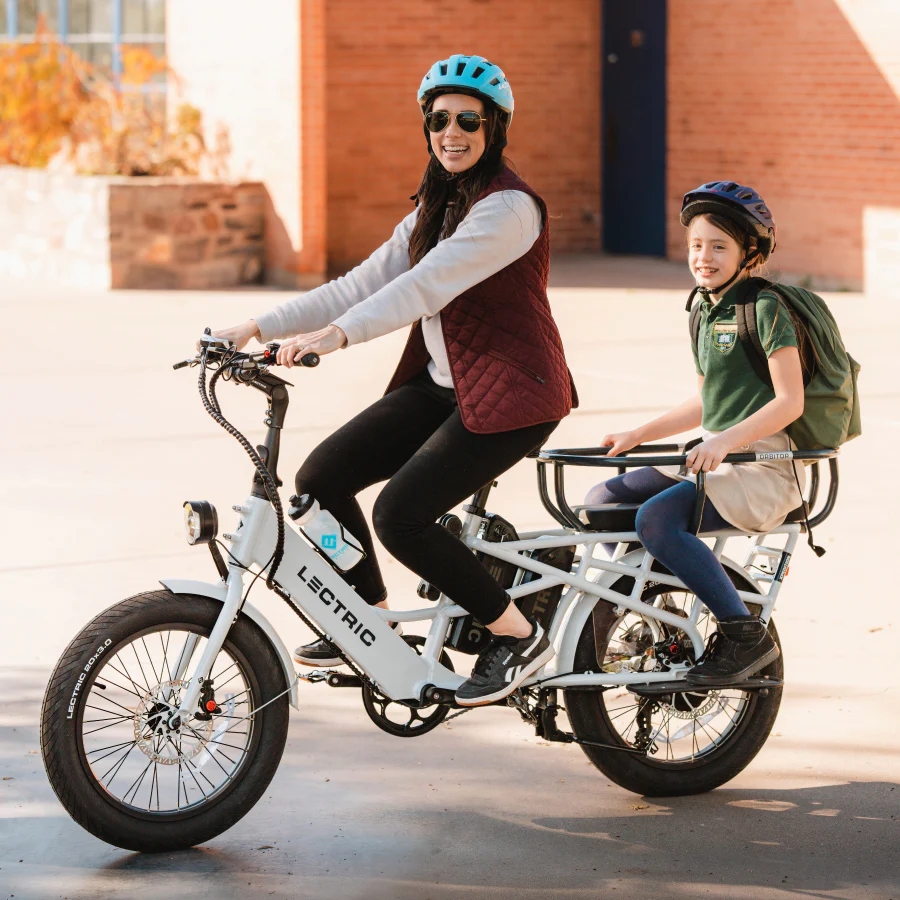

For riders carrying their kids, both the Xpedition and the Abound are good options, since they include the foot running boards, handrail cage and seat cushions with the bike for free. The Abound’s seat cushion is a little better, because it includes a back support cushion, whereas the Xpedition doesn’t. However, the 143 lb weight limit on the Abound’s back rack limits the size of the kids that the bike can carry on the back.
However, for people intending to carry their kids all year around, the Xpedition and Abound probably aren’t the best options. Rad Power offers the Canestoga canopy for $249 that attaches to its $179 Caboose handrail cage. The Canestoga canopy can be zipped down on the sides to provide more air and has a back pocket on the outside and an inside mesh pocket to carry snacks for the kids.

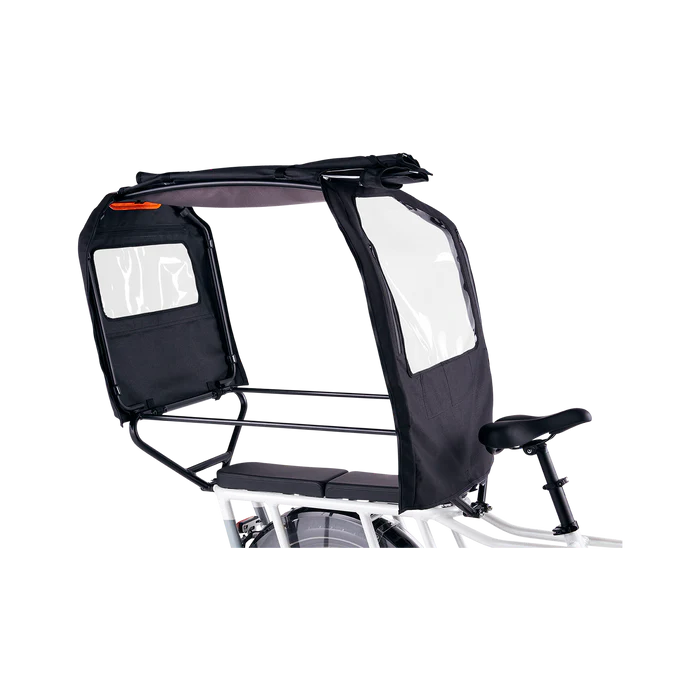

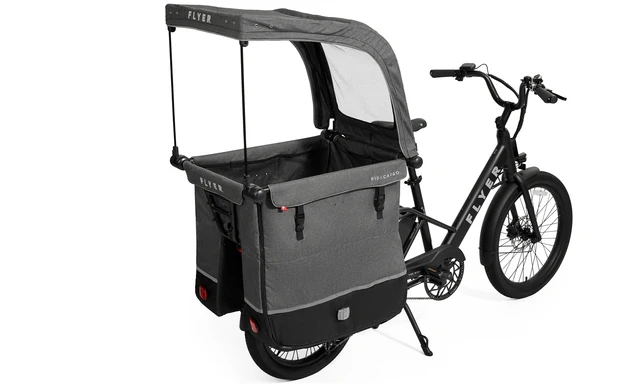
For parents who want more complete protection for their kids during bad weather, Flyer offers its Kid & Cargo™ Canopy for $199 and Carrier XL Hauler for $149 that attach to handrail cage included with the Via and Via Pro. Together these two attachments protect the legs and upper bodies of kids from the elements. The back and sides of the Canopy can be removed with a zipper to to provide more air, and the Canopy also has a zip-up front with a mosquito net to protect the kids from the bugs. For older kids, Flyer also offers a seat with a back rest and handlebars. Unfortunately, these accessories aren’t compatible with the L885.
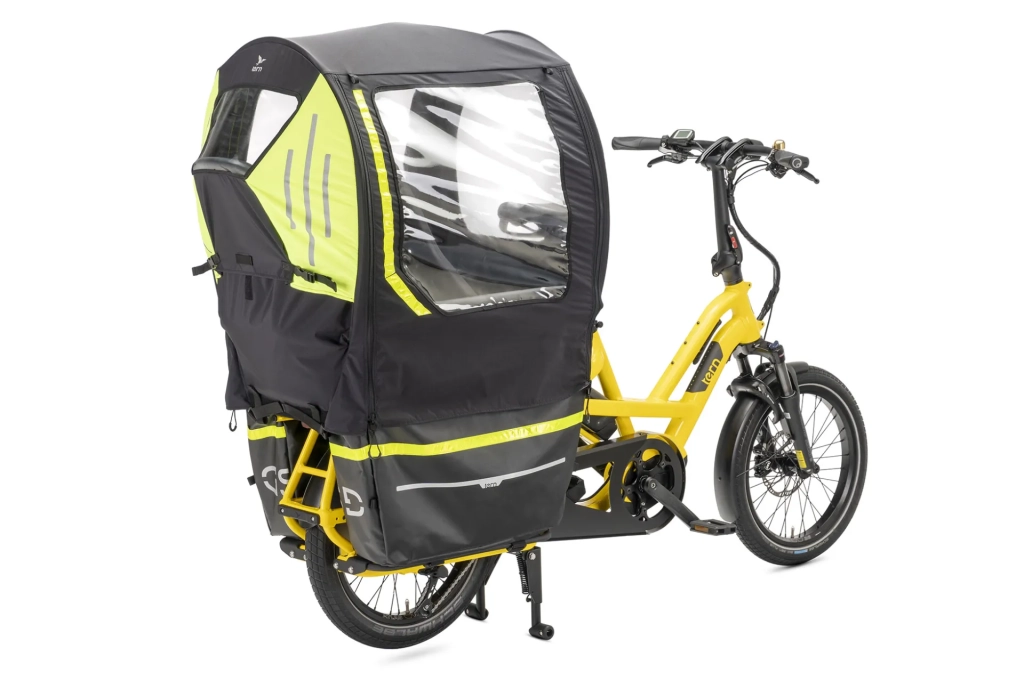
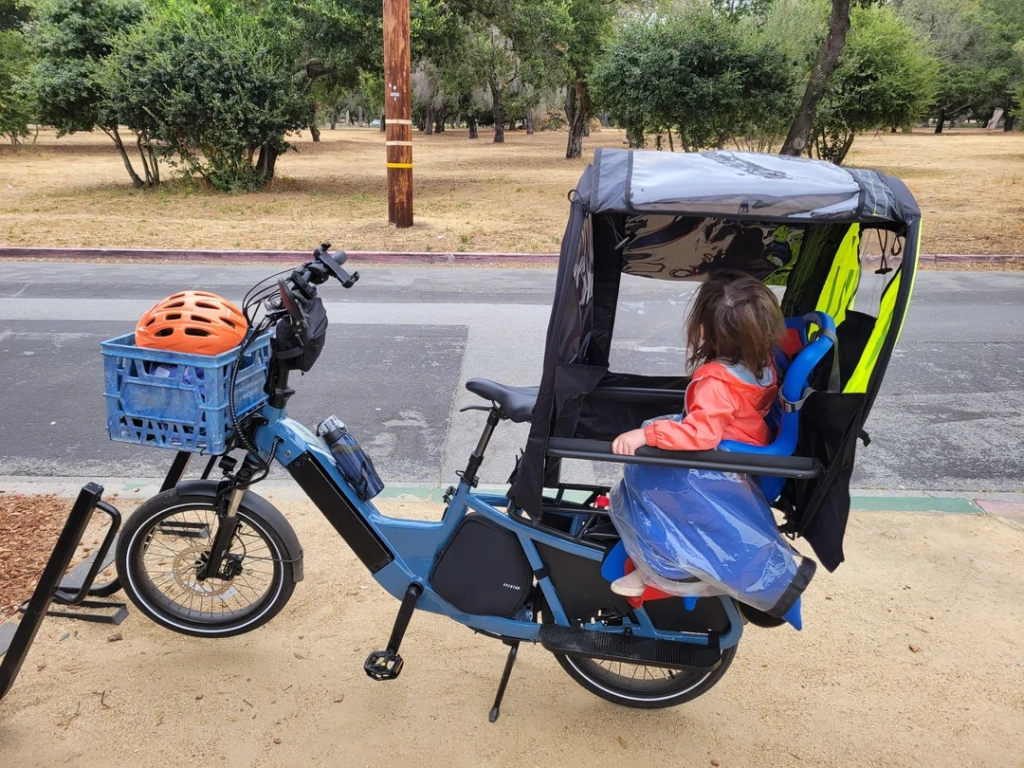
Tern offers a similar solution with its $230 Storm Shield and $230 Storm Box which attaches to a Clubhouse+/Gen 3 cage to protect the legs and upper bodies of the kids from the elements. Unlike the Via and Via Plus, Tern offers a double battery option on the GSD for long distance riding. A Reddit poster commented that Tern’s Storm Shield fits on Aventon’s Abound Handrail, so it isn’t necessary to pay $4500+ for the Tern GSD to use its accessory. There may be other Tern accessories that fit on other bikes.

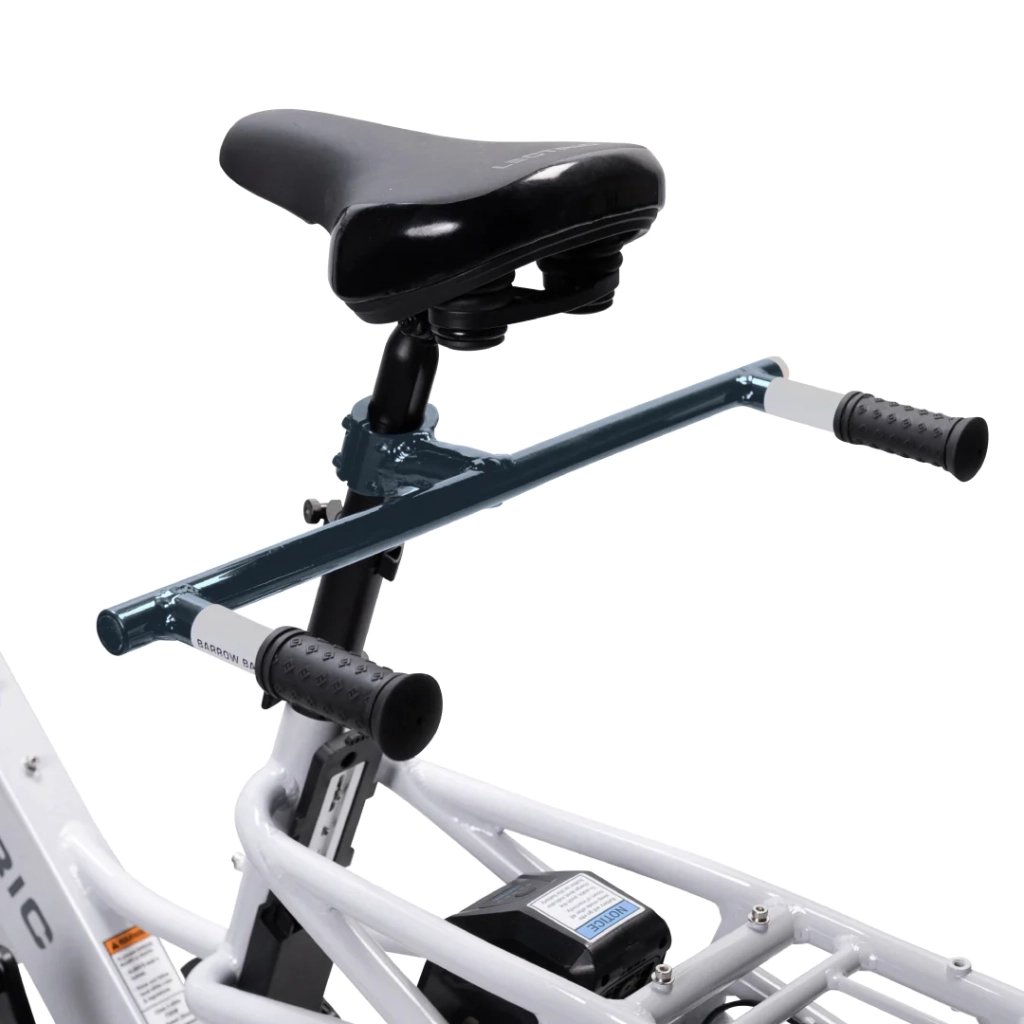
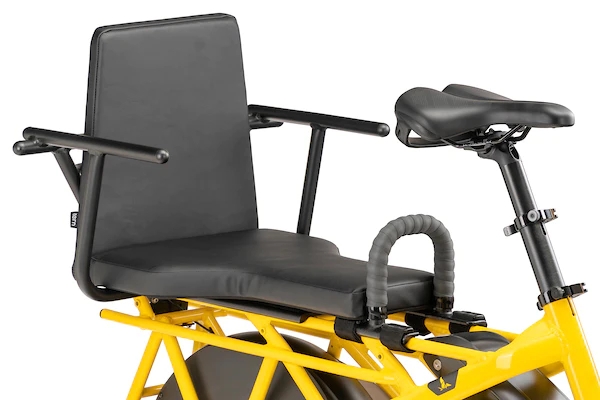

Riders who want to be able to carry an extra adult on the back have limited choices. The Xpedition offers the $89 Plus 1 Chair for adults and the $59 Barrow Bar for the passenger to grip that attaches to the seat post of the rider. Those same accessories will also fit on the AiPAS A6’s rear rack. Tern offers a spacious Captain’s Chair Gen 2 for $250, which is compatible with the GSD, Quick Haul and Short Haul, and it has long seat cushion, where a child can be placed in front of the adult. Tern offers its Sidekick Joyride Bars which give the passenger something to hold in front and they can double as a crate holder. For less obtrusive handles, Tern also offers its Sidekick Flat Bars that attaches to the rider’s seat post and its Sidekick Handle that attaches to the back rack. A back seat could probably be jerry-rigged for the other cargo bikes, but their back racks aren’t very strong, so it isn’t recommended.
Nonetheless, none of these extra seats are very comfortable for an adult because they don’t provide enough leg room on top of a small 20″ wheel. Plus, the back passenger is sitting at a much lower level than the rider, which blocks the back passenger’s view. In contrast most scooters and motorcycles allow the passenger in the back to be sit at that same height as the rider in front. What is needed is a higher seat for the back passenger, and the extra space under the seat could be used as a locked storage box, like on many scooters. Hopefully some bike manufacturer will make that kind of seat in the future.
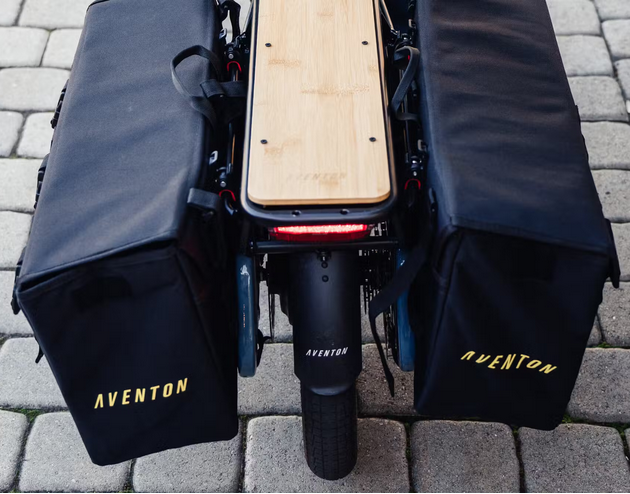

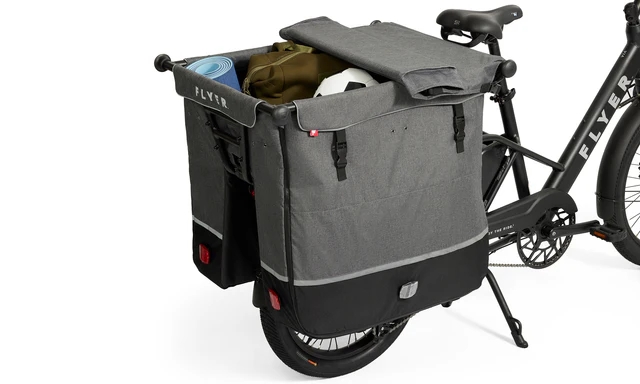

Most pannier bags are designed for the shorter racks of normal bikes, but many of the cargo bike manufacturers sell longer pannier bags designed for their bikes. Lectric sells its XP Cargo Pannier Bags (2) for $149, which hold 33 liters and 35 lbs each, or a total of 66 liters and 70 lbs. They are designed to be strapped to the back rack and the foot running boards, and are compatible with the AiPAS A6. They also work with Lectric’s Orbital cage and they can be folded flat to not interfere with passenger’s legs when sitting on the back rack. Aventon offers its Abound Pannier Set for $84.99, which also can fold flat, and they are currently included for free with the bike. Abound’s pannier bags hold 20 liters each or 40 liters in total. Velotric doesn’t offer rear pannier bags for the Packer 1. A Reddit commenter reports that Aventon’s Abound Pannier Set can work on the Packer 1, but the plastic clips don’t stretch over the thicker tubing in Velotric’s rack, and the bags don’t rest on the foot running boards, so they have to be attached with Velcro straps. Flyer offers a $39 Carrier Cover for its $149 Carrier XL Hauler, so it can be used like giant pannier bags on the Via and Via Pro.
Rad Power used to sell larger pannier bags, but now it only sells its $79 Ballard Cargo Bag which holds 28 liters. Rad Power’s bag is more water proof, but requires buying two bags to balance the weight on both sides of the bike. Rad Power’s Ballard Cargo Bags aren’t compatible with Thule Yepp Maxi Child Seats or rear-mounted baskets on the RadWagon.
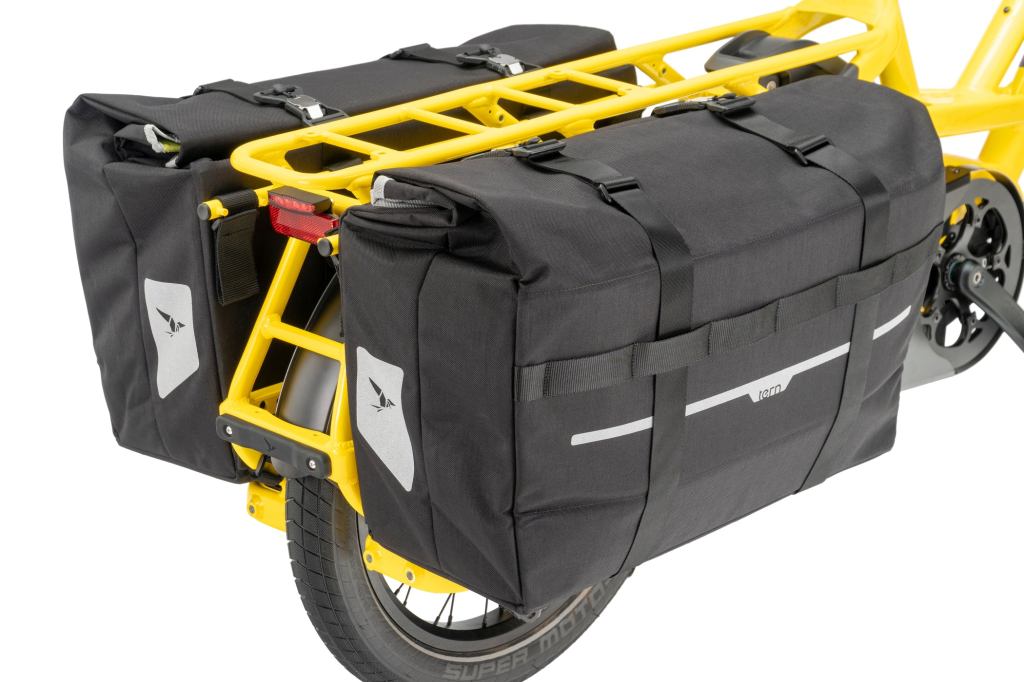
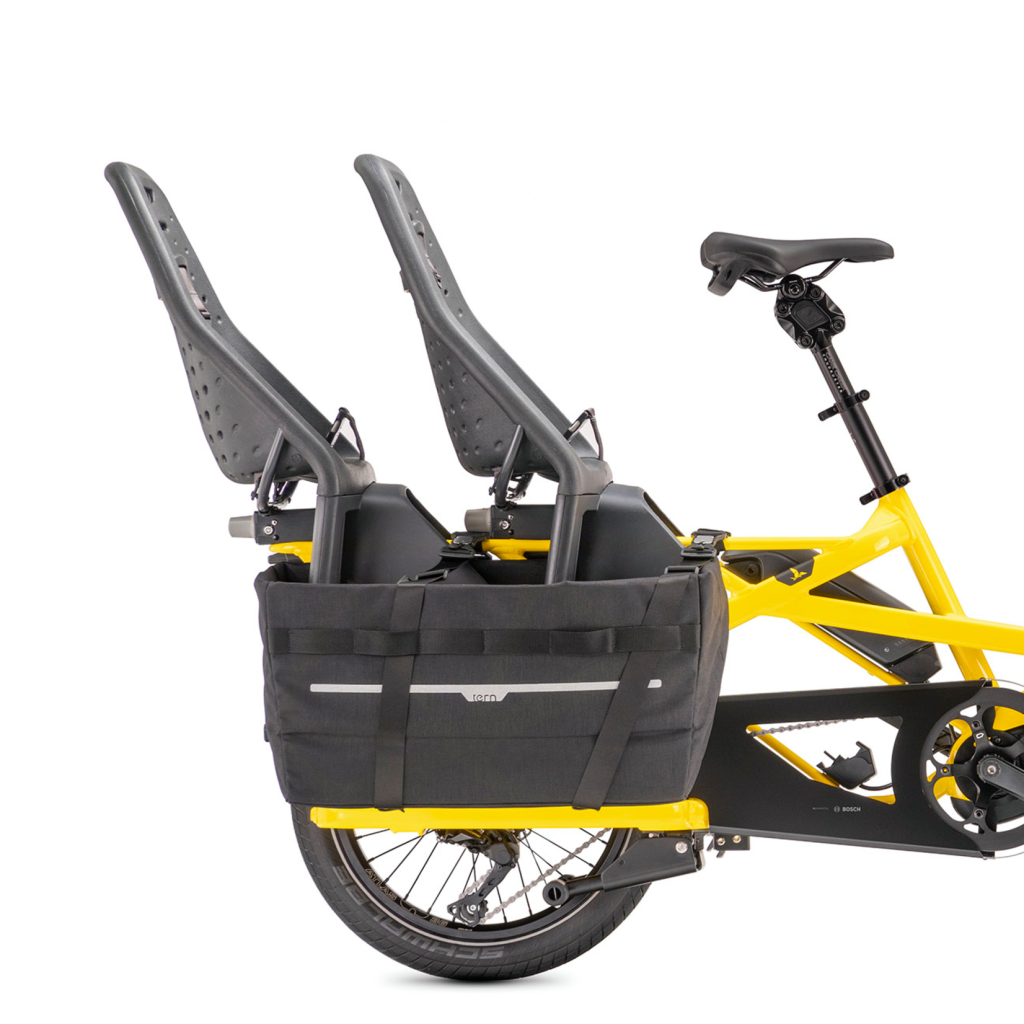


In contrast, Tern offers its $210 Cargo Hold 37 Panniers, $265 Cargo Hold 52 Panniers and $230 Storm Box for its cargo bikes, which are all compatible with Thule Yepp Maxi Child Seats, so that the kids can hang their legs into the open bags to be protected from the wind and water/slush flying up from the road. These pannier bags hold 37, 52 or 80 liters each, or a total of 74, 104 or 160 liters, respectively. The Cargo Hold 37 and 52 Panniers can be folded down and held shut with straps so they are unobtrusive when not being used. The larger Storm Box attaches to a $250 Clubhouse+ or $230 Clubhouse (Gen 3) cage at the top and the $135 Sidekick Wide Decks at the bottom. It comes with a flexible Kid Lid that wraps around kids’ bodies and can be cinched tight to protect them from the elements and with a lockable Cargo Lid to protect the contents.
These are my initial thoughts, just looking at the specs and accessories for the different cargo bikes. Of course, riding them is the real test, and I haven’t tried out any of them, so take everything that I say with a grain of salt. The goal is to be able to use these cargo bikes in place of a car. It is getting more cars off the road and less pollution into the air where the true benefit of cargo bikes lies.
